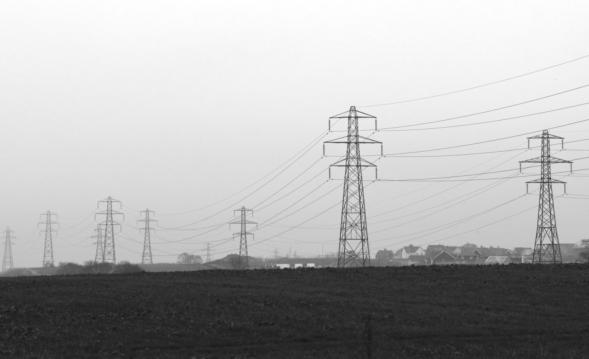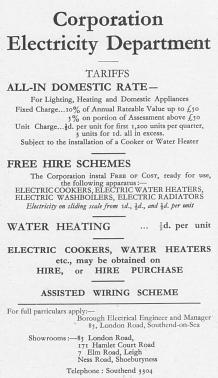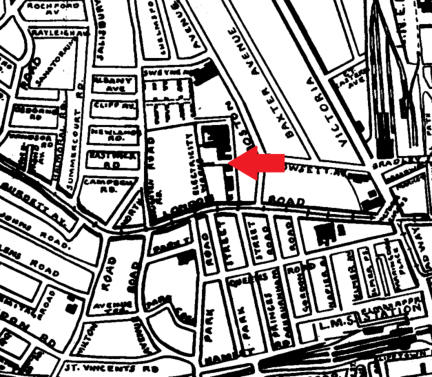Electricity Supply

Southend-on-Sea
Electricity
(Static)
was
first
discovered
around
600bc
by
Thales
who
was
a
Greek,
he
found
that
when
amber
was
rubbed
with
silk,
it
attracted
objects.
In
1600s,
William
Gilbert
used
the
term
“electricity”
from
“elektron”
the
Greek
word
for
amber.
Gilbert
experimented
and
wrote
about
the
electrification
of
many
substances.
Ben
Franklin
in
1752
flew
his
kite
in
a
thunderstorm
with
a
key
tied
to
the
string,
and
proved
that
static
electricity
and
lightning
were
the
same
thing.
Alessandro
Volta
an
Italian
invented
the
first
battery
in
the
1800s,
this
period
saw
great
advances
in
the
understanding
of
electricity.
In
1879,
Thomas
Edison
invented
the
incandescent
light
bulb,
and
in
1882,
opened
the
first
power
station
in
Pearl
Street,
New
York
City
which
powered
5,000 lights.
In
the
early
part
of
the
1900s
electricity
was
seen
to
be
the
future
to
power
lights
etc.,
for
up
until
now
the
lights
in
the
town
had
been
mostly
lit
by
gas,
the
supply
of
electricity
was
very
much
in
its
infancy
and
supply
was
short.
The
electricity
supply
was
likewise
short
between
the
wars
and
the
late
Mr
Robert
Birkett
(who
was
then
Southend’s
Electrical
Engineer)
installed
some
diesel
engines
from
German
submarines
at
the
Southend
works;
the
first
went
in
during
1920
and
further
diesels
followed
up
to
1926.
The
storm
of
criticism
aroused
by
these
diesels
raged
for
about
four
years
and
created
so
unpleasant
an
atmosphere in council circles that the very mention of the word ‘electricity’ was dreaded.
In
July
1920
an
expert,
Mr
C.
H.
Wordingham,
CBE,
was
engaged
to
advise
the
council
on
future
supply,
and
he
proposed
a
big
generating
station
at
Creeksea
at
a
cost
of
around
£400,000,
but
the
council
had
a
penchant
for
turning
down
advice
of
experts,
and
did
so
in
this
instance.
At
the
suggestion
of
the
Electricity
Commissioners
the
County
of
London
Electricity
supply
Company
was
approached
to
see
if
bulk
supply
could
be
obtained
from
the
Barking
power station.
In
1925
Mr.
Birkett
reported
on
the
success
of
the
diesel
engines
and
advised
a
station
on
these
lines
at
Southend,
which
was
subsequently
adopted
at
a
cost
of
£40,000.
In
1926
another
expert
was
consulted,
a
Mr
J.
H.
Rider,
who
advocated
a
generating
station
at
South
Fambridge
costing
£649,000,
but
the council also turned this down.
The
corporation
electricity
works
were
not
selected
as
a
capital
station
under
the
national
grid
scheme,
and
the
corporation
then
accepted
terms
of
the
County
of
London
Electricity
Supply
from
Barking.
In
1948
upon
nationalisation
of
the
electricity
industry
ownership
passed
to
the
British
Electricity
Authority
and
later
to
the
Central
Electricity
Generating
Board.
Electricity
connections
to
the
national
grid
rendered
the
local
power
station
redundant,
this
resulted
in
the
erection
of
pylons,
which
became
an
eyesore
in
our
countryside.
Incidentally,
it
was
proved
over
the
years that the ex-German submarine diesels served the town well and saved it from darkness on more than one occasion.
Southend Timeline Southend-on-Sea © 2009 - 2024. All Rights Reserved


1939 Corporation Electricity Advert



Southend-on-Sea’s No 1 History Website! Documenting The Town & The Townspeople

Now Incorporating The Sea Of Change Website
Website Info:


Chalkwell ▪ Eastwood ▪ Leigh-on-Sea ▪ Prittlewell ▪ Shoeburyness ▪ Southchurch ▪ Thorpe Bay ▪ Westcliff-on-Sea

Map of Corporation Electricity Works
SOUTHEND CITY
































































